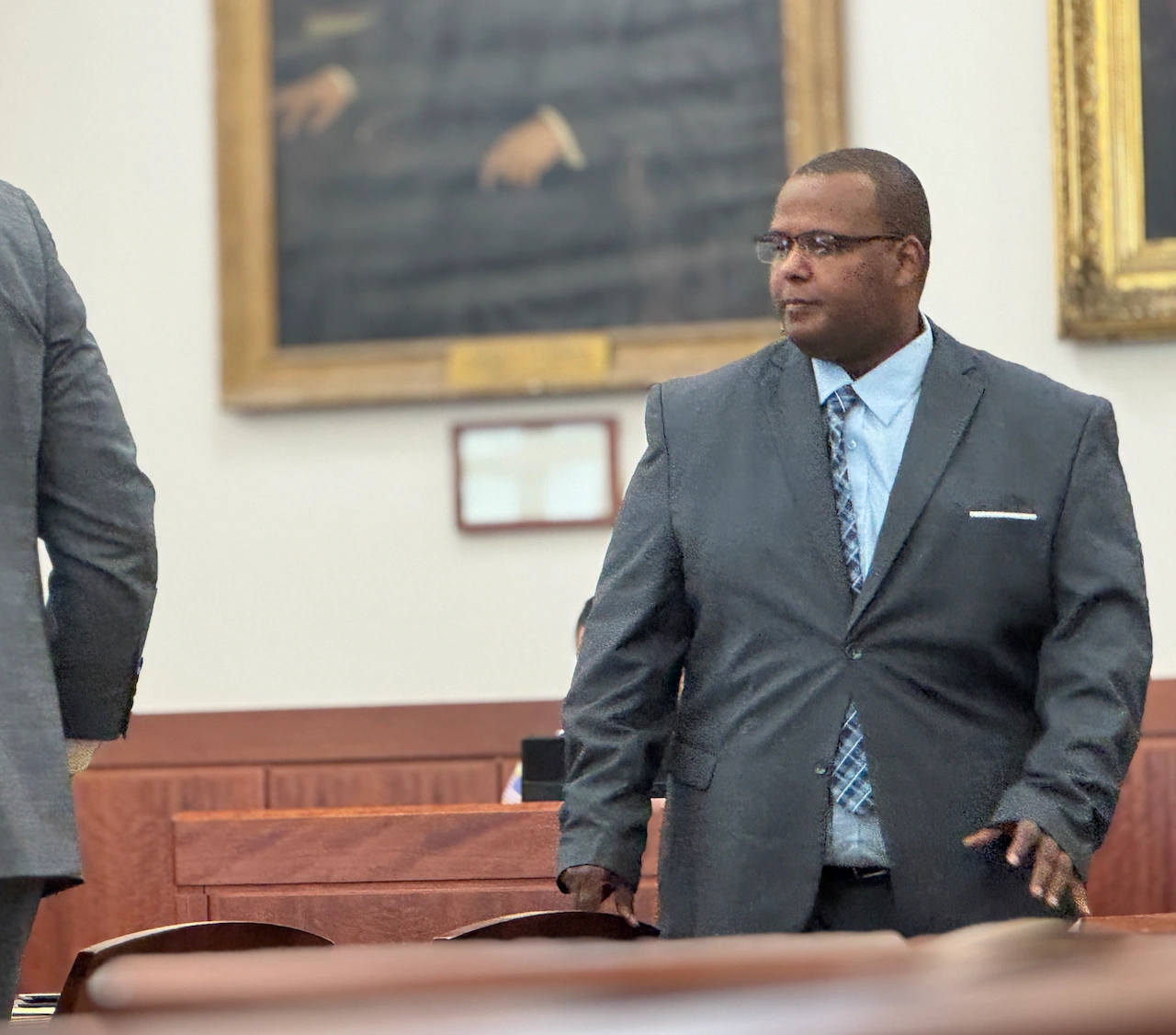
In a case that’s shaken Worcester for nearly a decade, the fate of Joshua Hubert — a 43-year-old man accused of kidnapping his best friend’s 7-year-old daughter, raping her and hurling her off a bridge — will soon be decided.
The girl, who accused Hubert, had named him to police officers in the early morning hours of Aug. 27, 2017, saying her “friend Josh” tossed her into the water of Lake Quinsigamond.
She, now 15, testified to her memory of that night in Worcester Superior Court on Sept. 8, on the first day of testimony in the trial against Hubert. He faces charges of forcible child rape, child rape aggravated by age, two counts of attempted murder and a single count each of kidnapping a child under 16 and strangulation.
But over the last week of trial, prosecutors admitted there’s no forensic evidence — even after testing of his car, the child’s clothing and her body after the attack — that ties Hubert to the crime.
There was, however, sperm cell DNA that belongs to the girl’s father, found on her underwear after she was thrown from the bridge.
The jury heard from several witnesses, including the girl herself, her parents and grandfather.
A man who claimed to have seen a car similar to Hubert’s on the bridge in the early morning hours of Aug. 27, 2017 also testified, along with several police officers from Worcester and Shrewsbury involved in the investigation, a doctor who treated the girl at the hospital and forensic experts.
Jurors were sent back just before 11:30 a.m. on Tuesday to begin deliberations, after receiving instruction from Judge Karin Bell.
Here’s everything we know about the complex case.
What happened in 2017?
The 7-year-old girl had known Hubert — or “Josh,” as she called him — her entire life. He’d been best friends with her parents for nearly 15 years by the time she was born, and it wasn’t unusual for him to be at their Forestdale Road home in Worcester for a summer family gathering.
What was unusual was what happened hours after the party ended on Aug. 27, 2017 — when Hubert, prosecutors say, took his best friends’ daughter from the living room recliner, still asleep in her pink princess onesie pajamas and wrapped in a blanket, and drove off with her in the middle of the night.
Around 2:30 a.m., Hubert placed the 7-year-old girl into his Saturn Ion and left the house, prosecutors said.
During the girl’s testimony at the start of the trial, she told the courtroom she woke up when she was lifted from the chair but thought it was her grandpa taking her to the air mattress in the other room.
But she realized they had been walking too long and were outside. So, she opened her eyes and saw Hubert putting her in his car, she said.
For more than an hour afterward, surveillance footage captured him driving around Worcester, and the girl recalled him pulling over on the street multiple times — including at a gas station — checking the trunk of his car on Southbridge Street and at his girlfriend’s home on Bernice Street. There, prosecutors say, he told her to delete all of his encrypted data stored with LastPass.com, a digital password management system.
At one point, Hubert said “Oops, I guess we’re lost,” she recalled.
Hubert pulled over and got in the backseat with the child at some point in the drive, prosecutors said, and raped her. She was strangled during the incident with both hands, which left bruises across her neck and body.
“When asked if she had tried pushing him away, she stated, ‘I tried that but it didn’t work,’” Worcester Detective Dylan Patient wrote in search warrant affidavits obtained by MassLive in 2018.
During the trial, she recalled trying to kick him off of her.
“I was thinking that he wanted me dead,” she said.
She said he tied a rope around her neck and put a plastic shopping bag over her head. She tried to pretend that she was already dead.
“If I breathed really lightly and quietly, he would think that I was dead and everything would stop,” she told the courtroom.
At one point, she recalled getting put in the trunk of the car.
Just before 4 a.m., Hubert stopped his car on the I-290 overpass at the Worcester-Shrewsbury line, according to prosecutors.
He threw the child, wrapped in a blanket, over the bridge into Lake Quinsigamond, prosecutors claim.
“The victim stated that she fell for a long time and landed in the waters below,” Patient wrote. The lake reaches depths up to 90 feet, with an average of between 21 and 36 feet.
She remembered being scared but also “slightly relieved” when she landed in the water “because he couldn’t hurt me anymore,” she told the courtroom.
“She stated that she began to swim to a building she could see, but the blanket she was carrying was getting very heavy, which made it difficult to swim. She then swam to a house and stated that she was able to stand up in the water,” the Worcester detective wrote after the incident.
A witness had texted a friend at around 4:15 a.m. that night, joking they’d seen someone throw something off the I-290 overpass when they’d been driving on the highway earlier and saw a Saturn parked in the breakdown lane. The witness also saw a man walking around the car, prosecutors said.
That witness, a 28-year-old man, testified to a different time in the courtroom over the past week. He told the jury he left from a friend’s home just after 3:00 a.m. on Aug. 27, 2017, which put him on the I-290 bridge at around 3:30 a.m.
He also testified that he’d lied in the text message to his friend, which he sent at 4:16 a.m., and had not actually seen a person throwing an item, but had simply seen the Saturn and a “medium-build man” outside the car.
The girl testified it didn’t hurt when she hit the water about 40 feet below her, and was able to stand at some points in the lake.
She said she swam nearly 100 yards to a home on North Lear Street, where a woman named Maeve Geary took her in. After wrapping the child in a towel and giving her dry Batman pajamas, Geary made two phone calls — one to a man, and the second to the police.
The man’s name was revealed in court Friday but MassLive is not naming him because he has not been charged. No additional information was given by the judge or prosecutors on the man’s identity, other than that he voluntarily gave his DNA sample on Dec. 14, 2017 to the Worcester Police Department, Bell told the jury.
This sample was then sent to the Massachusetts State Police Crime Laboratory and a DNA profile was created from his sample. State police forensic scientist Alanna Frederick testified Friday that when she tested the sperm found on the underwear — which came from “two male contributors,” she said — there was no match to Hubert, and there was a match to the girl’s father.
The Worcester District Attorney’s Office declined to comment on the third man.
The child was taken to the hospital after police arrived, where she gave a detailed account of the night, positively identified Hubert through pictures and officers observed strangulation marks on her neck. Blown out capillaries were also seen in her eyes.
She remembers watching “Doc McStuffins,” an animated Disney Junior series, on the TV in the hospital room.
But as a 7-year-old, she didn’t understand what rape was, she told the courtroom. She didn’t tell anyone about that part until 2022, when she told her cousin.
Her parents declined a full rape kit at the initial hospital visit, instead opting to give samples from under their fingernails instead of submitting the child to further tests and swabbing. There was a genital exam performed on the child the day after the attack, where doctors found redness on her genitals.
As the defense challenged her account in the courtroom, the 15-year-old began crying, but she refused to stop answering.
After his arrest, Hubert was suspended from his job at the Fay School in Southborough, a private co-ed school, where he’d worked in the school’s technology department as a systems support analyst since July 2017. School officials said he did not have any contact with children.
In a letter sent out to parents on Aug. 29, 2017, Rob Gustavson Jr., who was head of school at the time, said Hubert was hired in early July in the school’s technology department as a systems support analyst, and called the incident a “troubling event.”
Before that, Hubert worked as an emergency medical dispatcher in 2007 for the Sterling Police Department from May to August. He left the position during his one-year probationary period, the department said.
He was also a youth hockey coach.
DNA
Lawyers discussed in court last Monday how sperm cells were found on the girl’s underwear from the night of the incident in 2017 — but the DNA did not match Hubert.
Instead, it matched the girl’s father.
During the girl’s testimony, she said she no longer speaks to her father due to his problematic behavior, like not respecting her boundaries or privacy and drinking issues.
But despite their hard feelings, neither the girl nor her mother accused the girl’s father of any inappropriate sexual actions towards the girl, even though prosecutors say his sperm DNA was found on her underwear following the attack.
“Do you know how the sperm got on the underwear?” Larson asked the girl’s mother.
“I can’t say with 100% certainty, but our laundry hamper was in the bathroom, and everybody’s clothes went into it,” the mother replied.
The mother denied she put “dirty” underwear on her daughter, but said that the child had worn the same pair that morning and into the night.
She was wearing that pair after she changed into pajamas to sleep over at her grandparents’ after the party that August 2017 night, she said, and it was the pair on the child’s body when she showed up soaking wet in pink pajamas on a stranger’s doorstep by Lake Quinsigamond.
The girl vehemently denied her father ever assaulted her or ever would, and told the jury he had done “nothing” inappropriate with her in her life.
While the girl’s father acknowledged his DNA was found on her underwear, he had two different scenarios on how it could’ve ended up there.
One was the same laundry theory his ex-wife gave.
“We had multiple laundry baskets around the house … Clothes would just get mixed into one basket,” he said.
“[The laundry] would be brought down to our basement, where we had the laundry [machine], and it would all be washed together,” he said.
Additionally, clothes would often be left on the floor of the family’s bathroom, the father testified.
“What — if anything — have you ever done in that bathroom that could have resulted in your sperm getting on some of the laundry?” asked McShera.
“I have masturbated and I … also, [the mother] and I have had sex in the bathroom and things like that … even just cleaning up and things,” he said, and trailed off.
During a searing cross-examination, the father was pressed to explain further.
“Just a coincidence?” asked Hubert’s attorney, Kevin Larson, in the courtroom on Tuesday. The 42-year-old Worcester man on the stand blinked and said, slowly, “What is a coincidence?”
“Just a coincidence your sperm was on your daughter’s underwear the night she said she was kidnapped and thrown into Lake Quinsigamond?” the defense attorney asked.
The man softly replied, “Yes.”
New evidence after 8 years
Eight years after the initial accusation against Hubert, his attorney, Kevin Larson, was given new evidence Tuesday afternoon during the trial’s lunch break.
His lawyer claims the evidence supports Hubert’s innocence.
“I received cellphone tower mapping of my client’s phone that is exculpatory,” Larson said outside the courtroom at Worcester County Superior Court on Tuesday afternoon, meaning it is favorable to the defendant.
Larson said the new evidence — the cellphone tower mapping information — came from a 2022 law enforcement report that he had not previously seen.
The report was created by one of the government’s witnesses, Mark Sanders, who is a Criminal Intelligence Analyst from the New England State Police Information Network (NESPIN).
Dated Jan. 20, 2022, Sanders’ report was addressed to and appears to have been requested by Worcester Police Det. Cristin Chabot, according to a motion filing by Larson on Wednesday.
It includes “an animation” that depicts “the location and usage” of Hubert’s cellphone on Aug. 27, 2017.
This animation, and the report, show that Hubert’s phone was not on or near the I-290 bridge at the time the girl was thrown in the water, according to the filing.
“Neither Mr. Sanders’ report nor the animation were provided to Counsel for the Defendant as part of mandatory discovery in this case,” Larson’s filing read.
“Additionally, there are no references to Mr. Sanders’ report in the police reports previously provided to counsel.”
Though it appears the prosecutors currently handling the Hubert case — Emily Meyers and David McShera — were not aware of Sanders’ report, “the prosecution team, specifically Detective Cristin Chatbot, has had this information since on or about January 20, 2022.”
Both the prosecution and defense had already been working on a different “animation” that was created by Sanders as a trial exhibit, which included “certain surveillance video” and shows “a timeline of activity” for Hubert on Aug. 26 and Aug. 27, 2017.
However, on Sept. 9, Sanders “expressed concerns about the accuracy of parts” of that animation, given his report on the cellphone mapping data. Larson now believes the prepared exhibit is “inaccurate and misleading,” and that it will need to be “further edited or scrapped as an exhibit.”
In the seemingly revised exhibit shown on Monday, cell phone data showed how Hubert’s phone moved throughout the city in the early morning hours of Aug. 27, but was never in the area of the bridge.
Sanders testified that the cellphone data placed Hubert at the Shell gas station at 3:29 a.m. — not at the bridge, as the 28-year-old eyewitness had testified. He also said that by 4:13 a.m., the data shows “it does not appear the device location is consistent with that bridge.”
Another exhibit also showed surveillance footage from a car wash the following day that prosecutors claimed would point to Hubert vacuuming evidence from his car, but merely proved his son had been the one to vacuum the vehicle. Hubert’s defense attorney was also able to assert the contents of the vacuum was examined by investigators, who came up with no findings.
The defense considered “the possibility of requesting a mistrial,” according to motion, though none was filed by Sept. 15, and filed a motion for a required not guilty finding after testimony concluded, which was denied.
In an interview with police around 2:46 p.m. on Aug. 27, 2017, he encouraged police to track his phone.
“Track my phone, look at their cameras,” Hubert said.
“I didn’t go anywhere. I didn’t hurt this girl,” he told the detective.
But, he said, he didn’t have his phone with him at the police station.
“It’s at home. It’s dead,” he said.
The cell phone data places his cell phone near the Worcester Police station from 2:26 p.m. until 6 p.m., about four miles from Hubert’s house.
“What are we doing here?”
After a week of the trial, Hubert’s attorney shared his frustrations outside the courtroom on Friday.
“What are we doing here? I don’t know,” Larson said.
“That’s why I said in my opening statement that I’ve been screaming into the abyss for eight years … Everything that comes up points to Joshua Hubert’s innocence,” Larson said.
The trial is expected to wrap up at the beginning of this week, Bell told the jury Friday, and closing statements are expected from both sides before she allows the jury to begin deliberations.



